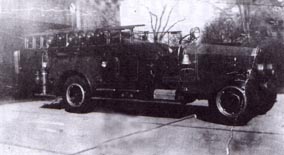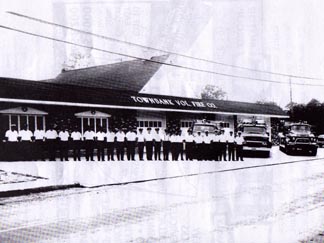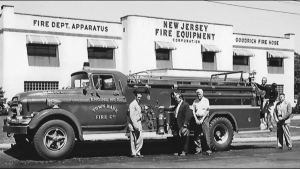HISTORY of the TOWN BANK
VOLUNTEER FIRE COMPANY
By Lewis H. Conley, Jr.
 Town Bank Fire Company’s first engine. |
The name “Town Bank” has historical significance in the area the Fire Company serves. Early settlers in this area made their living through whaling in the Delaware Bay. Many of them came from New England and Long Island, New York. Among them was Hannah Gorham. She was a granddaughter of John Howland. Howland had sailed to the New World in 1620 on the Mayflower. The first settlement in what is now Cape May County was established by these whalers in 1685 on the Delaware Bay’s southern banks. This settlement was called Portsmouth, and later Town Bank.
In 1723, the Court of Quarter Sessions divided Cape May County into the Upper Precinct, the Middle Precinct and the Lower Precinct. Much of what was then named the Lower Precinct became what we now know as Lower Township, after the municipalities of Cape May, West Cape May, Cape May Point, and the Wildwoods were formed.
Many whales were killed in too short a time, causing the destruction of the Delaware Bay’s whaling industry. Tides, storms, and erosion eventually washed the village into the Bay, so that the area now known as Town Bank is a namesake, and not the original settlement.
Lower Township remained a sleepy farm and rural setting until the end of World War II when a developer by the name of Warren Smadbeck rediscovered the area of Town Bank (Cape May Beach) and North Cape May. Smadbeck saw the potential of this area as a vacation and bedroom community for the returning veterans. He was a founder of two developmental groups, the Mayflower Developmental Co. and the Cape May Beach Development Co.
In October of 1945, a group of residents gathered at the Rendezvous, now Harpoon Henry’s, to form a fire brigade, with the hopes of eventually acquiring some firefighting apparatus and beginning a fire company. Exactly what happened at that meeting is not known. What we do know is that an association was formed with Harry Gerber as Chief and Dick McClymont as President. Other charter members included Ralph Ackroyd, Charles Fairburn, Fred Geckler, William Gray, William McCollough and Milton Shepherd. A Certificate of Incorporation was officially filed for the Town Bank Firemen’s Association on January 3, 1946.
Later that year, they purchased their first piece of fire apparatus, a 1927 Maxim triple combination pumper from Tuckahoe, New York.
Developer Warren Smadbeck was approached about donating some land to place a building to house the firetruck. He donated all of the land that the original firehouse was built upon, with enough room for expansion. To guarantee that there would always be a firehouse to protect his development, Smadbeck deed restricted the land so that it could only be used for a firehouse. The site of the original firehouse is in the area of the current multi-purpose room.
On April 23, 1951, Fire Company President William Gray and Secretary George Stoudt negotiated with Warren Smadbeck once again, this time for the donation of two lots that could be offered for sale to help defray expenses in the purchase of firefighting equipment.
It was soon obvious that the old barn would no longer be suitable as a firehouse and the company set out to raise funds to build its own building.
On August 27, 1954, Frank Moran, Building Inspector for Lower Township, issued a building permit for the construction of the original 33′ x 60′ firehouse, with an anticipated cost of construction of $5,000.00.

The original firehouse after the first expansion – circa 1955.
On March 1, 1957, the official name of the fire company was changed from the Town Bank Firemen’s Association to it’s current name of Town Bank Volunteer Fire Company, Inc.
At a meeting of the Town Bank Firemen’s Association on June 6, 1960, St. Raymond’s Church sought and received permission to hold Sunday Mass in the firehouse. The masses were later expanded to several masses and eventually became St. John of God Church, which is now located farther east on Town Bank Road.
The area grew in popularity and homes were being built rapidly. This growth spurred the expansion of the firehouse in 1967 to 5 bays, offices and a multi-purpose room.
 Building Dedication – 1967 |
With the cost of land so high along the barrier islands of Avalon, Stone Harbor, and the Wildwoods, many “locals” now discovered the beauty and economy of this Delaware Bay community and the 1980’s saw the beginning of a second building boom. This rapid growth spurred the Fire Company under the leadership of Chief Marcus Patterson, Sr. and the Fire District to charter a feasibility study for expanding the existing firehouse. As the community was growing, so was the size of fire apparatus. By the time that the feasibility study was completed, it was determined that a totally new and much larger firehouse would be needed.
 A Committee was formed under the chairmanship of Fire District President Ray Brown to look at and evaluate firehouses to determine our needs. After years of looking, evaluating, and planning, it was determined that the only way a facility could be built was through the Fire District by bonding. President David C. Douglass on November 4, 1989, along with his administrative officers, Vice President Robert Nickerson, Secretary Gregory Christman, and Treasurer Russel (Dick) Coombs, turned over all grounds and buildings to Fire District No. 2.
A Committee was formed under the chairmanship of Fire District President Ray Brown to look at and evaluate firehouses to determine our needs. After years of looking, evaluating, and planning, it was determined that the only way a facility could be built was through the Fire District by bonding. President David C. Douglass on November 4, 1989, along with his administrative officers, Vice President Robert Nickerson, Secretary Gregory Christman, and Treasurer Russel (Dick) Coombs, turned over all grounds and buildings to Fire District No. 2.
While the building was being constructed, the Company’s thoughts turned to the extensive waterfront and waterfront development. A purchase was made from fisherman Charles McCollough to purchase a work hull for a very reduced cost. Constructed of aluminum, it seemed perfect for conversion into a fireboat. Under the leadership of Chief Brown, a committee of water-oriented firefighters spent countless hours designing and building the Robert C., currently moored at Utsch’s Marina at the foot of the US 109 bridge going into Cape May.
 In December, 1992, a certificate of occupancy was delivered for the building you see here today – a modern, state-of-the-art building for which the fire company and the community can be proud.
In December, 1992, a certificate of occupancy was delivered for the building you see here today – a modern, state-of-the-art building for which the fire company and the community can be proud.
In October, 1995, the Fire Company took delivery of their twin 1250 gallon-per-minute Pierce pumpers and 100-ft. Pierce Aerial Tower, culminating 15 years of planning and waiting for a firehouse large enough to house the apparatus.1994 Twin Pierce Pumpers and 100-ft. Pierce Tower
Appropriately, the Fire Company celebrated its 50th Anniversary in 1995 with the official dedication of the new firehouse, housing of the “Twins ‘n Tower” (TNT), and dedication of the fireboat Robert C.

